#indigenous Aymara
Photo

Liubomir Fernández,Elizabeth Prado [email protected]
THOUSANDS OF AIMARAS ARRIVE IN LIMA...They had a massive farewell in various parts of the lakeside city. The Andahuaylas delegation is already in Lima. Between tears and recommendations to take care of themselves, hundreds of Puneños fired nearly 7,000 Aymara who left for Lima to demand the resignation of Dina Boluarte. Those who will represent Puno in the capital left aboard buses, vans, cars and trucks. As they passed through various towns they received all kinds of support. They gave them products such as cookies, water, bread, fruit, soda, tuna, coke, and even money so that they can resist as long as necessary until they achieve their political purpose. “We are grateful for all the love that they have just shown us in each town. We are not going to let them down. We are not going back until Dina Boluarte resigns. He has ignored us. He has humiliated us. Now he is going to know the strength of the aimaras. The strength of the people who work the land,” said José Colque Mamani, leader of the Ilave mountain range.
The convoy, made up of around 120 vehicles, left from the Desaguadero district. Subsequently, the caravan concentrated in Ilave and then they all headed towards the city of Puno. There thousands of people stationed themselves on the side of the road where the procession passed to give them their support in money and all kinds of food. The Aymara communities reported that as long as their countrymen are in the capital, the indefinite strike with roadblocks will continue. The following days they will send new representatives to the capital. Each unit has a human team that will be in charge of caring for the wounded if there is police repression. University students joined the March of their 4 Earlier, from Parque de la Madre, dozens of students from the Puno Altiplano National University (UNA) left for Lima. They will join their colleagues from other universities in the capital and, at the same time, they will wait for the Quechuas and Aymaras so that the Puno bloc is united.
“We are offended because of what Dina Boluarte said. We are not drug traffickers or terrorists. Now they are going to meet us. We will continue in the fight until the final. They are not going to make fun of us. Not that. Impossible,” said Manuel Flores, a social work student.
(The Republic, January 18, 2023)
https://larepublica.pe/politica/actualidad/2023/01/18/protestas-en-peru-miles-de-aimaras-llegan-a-lima-para-que-dina-boluarte-los-escuche-puno-cusco-apurimac-marcha-de-los-4-suyos/
#eru unrest#Marginalized Peru Populations#18 january 2023#Racism#Peru unequal power relationships#indigenous Aymara#Aymara indigenous population#Aymara indigenous protesters#Peru indigenous repression#Lima state of emergency#Human Rights#right to demonstrate#Aymara communities
19 notes
·
View notes
Photo

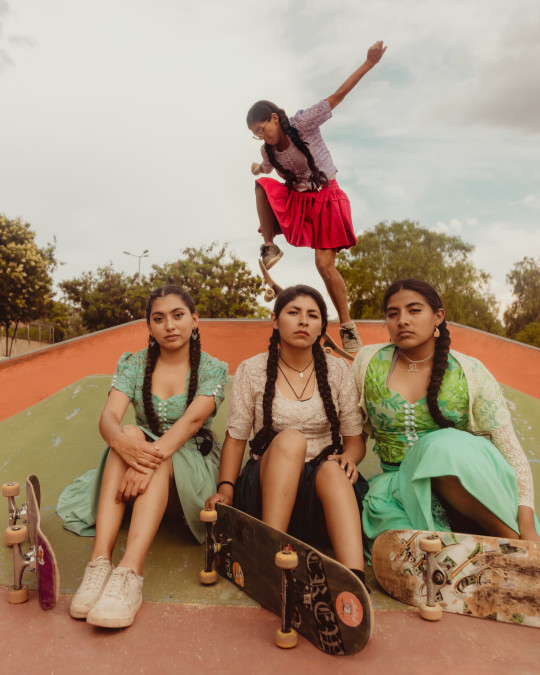
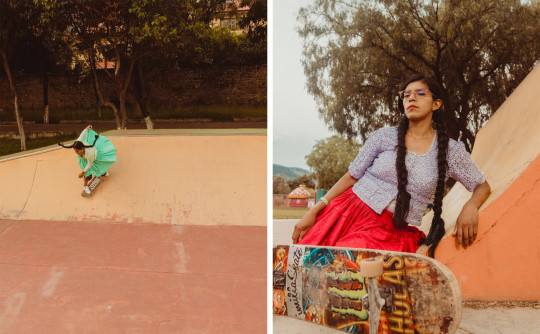
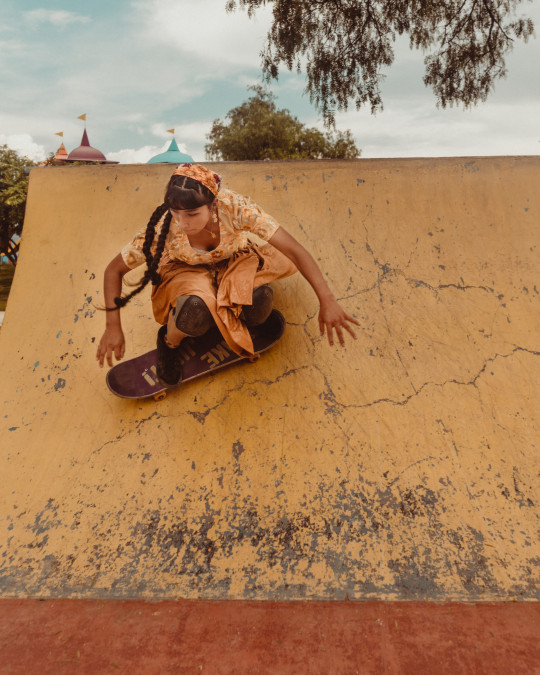

- Celia D. Luna, “Cholitas Skaters” (2023)
Bolivia’s Indigenous Quechua and Aymara women, known derogatorily as “cholitas,” were marginalized and ostracized from society. Distinguished by their long braids, wide skirts, and bowler hats—an amalgamation of styles resulting from Spanish colonizers forcing Indigenous people to adopt European styles during the Inquisition—the style evolved into a symbol-rich, empowered look.
#chromatic voice#we all make art#celia d luna#quechua#aymara#indigenous people#indigenous women#usermarmalade
859 notes
·
View notes
Photo

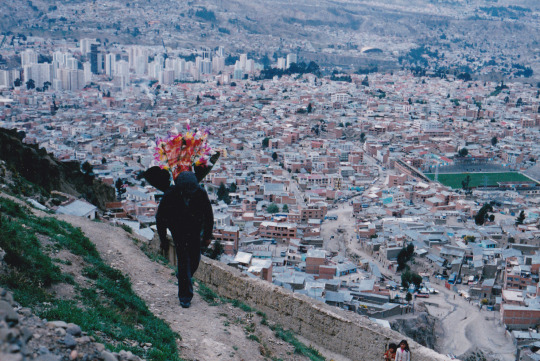
The Secret Nation (La Nación Clandestina) | Jorge Sanjinés | 1989 | Bolivia
#la nación clandestina#aymara#jorge sanjinés#bolivian films#native american movies#cinema#film#bolivia#movies#auteurs#film d'auteur#indigenous movies#bolivian#80s cinema#the secret nation#1989#latin american cinema#latin american films
140 notes
·
View notes
Text


English is a West Germanic language that originated from Ingvaeonic languages brought to Britain in the mid-5th to 7th centuries AD by Anglo-Saxon migrants from what is now northwest Germany, southern Denmark and the Netherlands.

In other words,English is a European language. American languages are The Indigenous languages of the Americas are the languages that were used by the Indigenous peoples of the Americas before the arrival of non-Indigenous peoples. Over a thousand of these languages are still used today
The most widely spoken Indigenous languages are Southern Quechua (spoken primarily in southern Peru and Bolivia) and Guarani (centered in Paraguay, where it shares national language status with Spanish), with perhaps six or seven million speakers apiece (including many of European descent in the case of Guarani). Only half a dozen others have more than a million speakers; these are Aymara of Bolivia and Nahuatl of Mexico, with almost two million each; the Mayan languages Kekchi, Quiché, and Yucatec of Guatemala and Mexico, with about 1 million apiece; and perhaps one or two additional Quechuan languages in Peru and Ecuador. In the United States, 372,000 people reported speaking an Indigenous language at home in the 2010 census. In Canada, 133,000 people reported speaking an Indigenous language at home in the 2011 census. In Greenland, about 90% of the population speaks Greenlandic, the most widely spoken Eskaleut language.
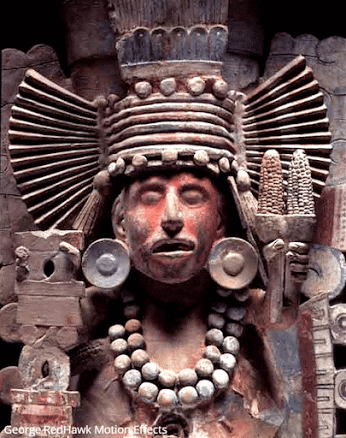
#kemetic dreams#brownskin#brown skin#asians#asian#native american#native#native girls#nativebaddiez#nativeamericans#nativebigtitt#ndn#native women#navajo#first nations#indigenous#nahuatl#indigenous languages#Kekchi#Aymara#Eskaleut#Yucatec
21 notes
·
View notes
Text
The Three Principles we must follow when making medicine in the Quechua Andean Tradition are:
Allin Yachay : Good Thoughts & Good Knowledge. Heeding always to Ancestral Wisdom. Knowing what is Right. In modern times this includes all forms of our cultural, traditional knowledge aswell as integrating new western-scientific knowledge.
Allin Munay : keeping a Good Heart, wanting the Right Thing, acting out of kindness, out of love, holding appreciation for our medicinal allies, and in loving remembrance of the Ancestors (human and non-human) who've taught us the medicine we're making. It also includes keeping Right Relation with all our Spirit allies, ancestral, herbal and other kinds, through maintaining proper Reciprocity (Ayni).
Allin Ruray : Good Work. Putting your hands to work on the Right Thing, based on what you know and how you feel. Your Actions must reflect the best out of both Mind and Heart, and be the Right choice, the right action, for both healer and patient. This also requires the supervision of Ancestral Spirits who must approve and allow for the healing process. If there's disapproval from the Spirits, for example, due to a lack of knowledge, a lack of clarity, being the wrong person or simply not being the right time for it, the healing will not occur and the patient must be turned away or redirected elsewhere, where they may find their right path.
These Three Principles represent how the Mind, Heart and Actions of the Healer must be in internal harmony for the act of Healing to happen, aswell as the harmony that must exist externally between Healer and the Natural-Spiritual environment in order to lead the patient back to their own internal and external harmony.
No wrong thought should cloud the mind, no grievances should cloud the heart, and our actions mustn't be unqualified nor uncalled for, to allow the patient to be led back to Good Health, Allin Kay, and Right Living, Allin Kawsay.
#blood and water#Regina Mundi#Herbalism#Indigenous herbalism#Native herbalist#Indigenous herbalist#Andean Medicine#My notes#All this came from me hearing an aymara relative mentioning just how we must be in the Right Mindset to work our medicine#and left me thinking about what that looks like for me#''The Right Mindset“ is these three things for me#Right Mind Right Heart and Right Action#Both inside ourselves and in relation to others#And the Others including humans involved but also Spirits#Ancestors Herbal Allies etc etc etc#yerbatera#khuyasqay yuyokunay
3 notes
·
View notes
Text
Shoutout to the Sudadera Celeste and Big Man Splatoon which singlehandedly feed into my "The Splatlands are LITERALLY Latin America-coded" belief
#dreamy talks#likeeeeee im sorry but the fact that the sudadera celeste has a spanish name even when the game is set in english??#and in the japanese version it has 'セレステ' in the name which is just katakana of Celeste (Light blue in spanish)#LIKEEEEE. same goes for the sudadera roja and the ocho octophones (blancos) but like#what makes me specially insane is that the Sudadera Celeste ALSO has patterns that are very common in south american indigenous cultures#I have noticed the most similarity with Aymara and Mapuche. the sudadera celeste has been driving me insane since the moment#i first saw it bc not only the spanish name but also cuz the patterns. were SO familiar. Like I have seen handmade clothes/tapestries/etc#with those EXACT same patterns it just drives me insane how familiar Splatsville FEELS as a latin american and i love this game sm#cuz of that ngl. It's just nice it kinda makes me feel at home almost?#also im just basically scrapping for crumbs of rep lmfoajfodnfod#I wish the wiki didn't (wrongfully) say that the patterns of the Sudadera Celeste are Inuit-inspired#they resemble native andean textile patterns much more...
7 notes
·
View notes
Text

FUNNY ENOUGH, SHE IS LITERALLY A WAR CRIMINAL XD
I read a few months ago Entrapta had a headcanon of being afrolatina but mine is she's a quechua or aymara girl, from that area, she really looks like an andean indigenous girl
#art#drawing#illustration#chileart#digital art#fanart#entrapta#she ra#she ra and the princesses of power#entrapta she ra#actually autistic#autism#autistic artist#autistic
307 notes
·
View notes
Text

Fiesta de Gran Poder parade, La Paz, Bolivia: The annual Fiesta del Gran Poder festival in La Paz is the most popular religious festival in Bolivia, and pays homage to an icon of Jesus known as Nuestro Señor del Gran Poder (Our Lord of Great Power). Although it is nominally a Catholic festival, it owes much more to indigenous Aymara roots, and it's a fantastic cultural expereince for anyone wanting to see the real Bolivia. Every year, more than 30,000 dancers representing La Paz’s neighborhoods and folkloric groups, dance along a 6 km route through the city’s streets.
123 notes
·
View notes
Text
On the border of Peru and Bolivia, the Waru Waru—an indigenous Quechua word that means ridge—are once again protecting potato and quinoa crops as they did in the region 2,000 years ago.
"It is an agricultural system that lets us face climate change, which has changed the seasons of the year. It is very beneficial in times of drought and frost," farmer Cesar Cutipa, 42, told AFP.
Puno lies on Lake Titicaca about 3,812 meters (12,507 feet) above sea level. Farmers have made six Waru Waru nearby in flood-prone fields.
Furrows form a rectangular platform, where planting is done. Surrounded by water, the planting beds are up to 100 meters long, between four and 10 meters wide and one meter high.
The water around the plants creates a microclimate, absorbing heat from the sun during the day and radiating it back at night to ward off frost in sub-zero temperatures.
"The Waru Waru cannot flood during the rainy season because they have an intelligent drainage system that reaches the river. They have many advantages," agronomist Gaston Quispe told AFP.
In 2023, when Puno suffered one of the largest periods of drought in almost six decades, Waru Waru helped farmers cope with lack of water and avoid food shortages.
The area is home to mostly indigenous farming communities, mostly Quechua in Peru—and up the Andes—and both Quechua and Aymara in Bolivia.
"We are able to live here peacefully because we have our potatoes, our quinoa and barley. We can be in peace without going to the city," said 22-year-old farmer Valeria Nahua.
185 notes
·
View notes
Photo
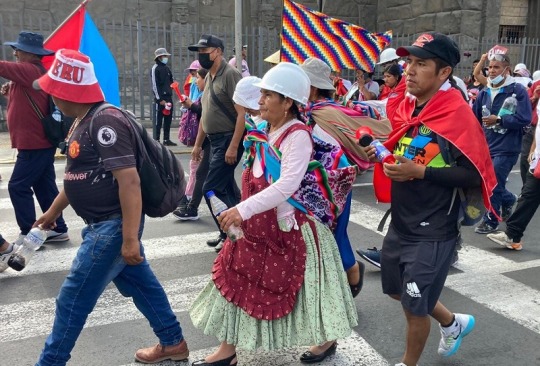

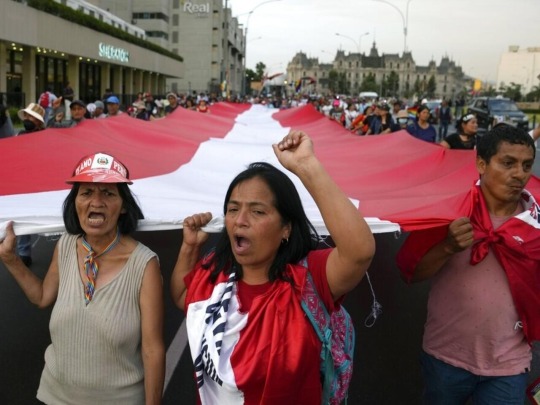
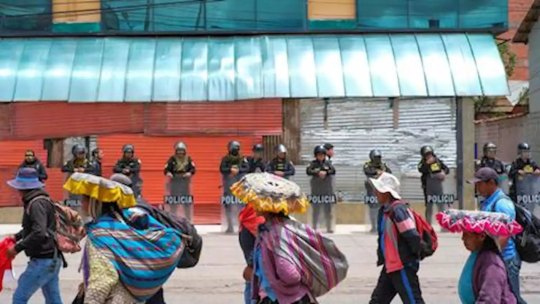

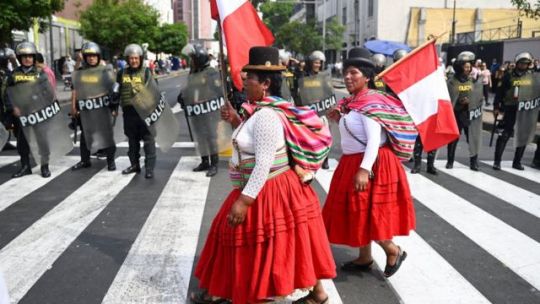
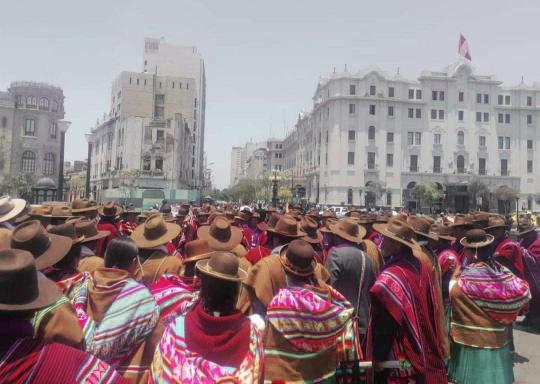
Citizen insurgency and role of Andean women 2023-02-03
By Linda Lema Tucker . sociologist
Women are being protagonists of this great story that is yet to be written: the protests of the citizen insurgency. These days, in Lima, great days of democratic struggle are taking place, in which hundreds of women, from the most infinite corners of Peru, with loud and forceful voices, demand the resignation of Dina Boluarte, the closure of Congress and Constituent Assembly.
They left behind their children, the harvest, the cattle. They have broken the private sphere and have joined political affairs, to propose solutions to old problems that are still unresolved. They have faith that a new dawn in Peru is about to arrive. In protests they are distinguished by their colorful and bright skirts, their woven llicllas that they carry on their backs and shoulders, and their wonderful Aymara or Quechua language. They are not willing to return to their towns until Dina resigns, because her resignation is to fulfill that promise they made to the sixty murdered Peruvians, who would fight until the end, until this dictatorial regime abdicates. They carry in their memory and are the inspiration of their struggles, the story of brave Quechua and Aymara heroines, who preceded them as inspiration. They also know that this is a new time, in which the collective force has to overcome the old that has to lay the foundations for a rebirth of a new state, in which forgotten sectors of the country participate in power in a constitution of a new republic.
Women, the streets and the new leaderships These days, with great intensity and force, women march through the streets of Lima, launch harangues, sing and dance huaynitos, demanding the resignation of "la Dina", as they usually call her. We have walked blocks and blocks with them, until the police surprised us and repressed us with tear gas. The gas suffocated, when I saw that, in their saddlebags, they carried handkerchiefs and vinegar to avoid burning in the respiratory tract. We continued marching and he heard the loudest proclamation, "Dina, murderer, the people repudiate you." Until arriving at Plaza Dos de Mayo, where a commission of women waits for the compañeras to get sandwiches and drinks. That solidarity surprises me. But it is striking to see new women leaders, Quechua and Aymara, who, with braids, flip flops and a Peruvian flag tied around their necks, continue to harangue with surprising force, offer interviews and express their feelings and opinions about the meaning of the struggle. of their communities and towns. They do not stop demanding Boluarte's resignation, saying: “She ordered our children and brothers to be killed and has not asked for forgiveness. She is a ruthless woman, who is militarizing our towns to continue killing us." This energetic political possession with which women speak is an expression that something important is happening in deep Peru.
They continue to protest in the central streets of Lima, in addition, they have done so in districts called exclusive, San Isidro and Miraflores, where, before, some "gentlemen" believed they belonged to them. Let us remember that, not long ago, Andean women were kicked out of Larcomar in rejection of their ways of dressing and customs of a country that, paradoxically, has a multiethnic and multicultural origin. In addition, for many years, the program La Paisana Jacinta was broadcast on television, which constituted an insult and a racist attack on the dignity of indigenous peasant women.
That is why, the insurgency that is developing now against this regime, is marked by the historical accumulation of so many abuses, discriminations and violence against the majority of the population that has an indigenous origin, therefore, the necessary democratic change must come from the original peoples in order to eliminate so much pain and establish a different destiny for millions of Peruvians.
Fighters tied to history Throughout these days, we have observed that women are united by history, that history that feminist women are now writing and that is being repeated today, by Andean women, university students, workers, housewives, and feminists, who they have joined the historic struggle in the streets, in the relief brigades, in the alternative press, in the aid of food on the highways, the women with multicolored skirts, flip flops and huaraca in hand, confront the police – like we have seen in the networks -, actions, all of women to put an end to a totalitarian regime, anti-women, as Micaela Bastidas did in Cusco, or Rita Puma Justo, in Puno, heroines who, like many others, raised their voice of protest and participated in historical episodes, against domination and gender violence, exercised by patriarchal and oppressive regimes, which considered indigenous women as an inferior race and gender.
https://www.noticiasser.pe/insurgencia-ciudadana-y-protagonismo-de-las-mujeres-andinas?fbclid=IwAR3sF6SsW1rbFRvTjfcjg6TGrVeTQ7P1uiekHjH5LohdfnxElqve66x6CJw
#Peru#Peru unrest#Linda Lema Tucker#dina boluarte#peru protests#indigenous repression#indigenous Aymara women#racisme#Peru racisme#human rights#Peru highlands women#Peru: Aymara#Peru:Quechua indigenous population#indigenous Peru#Andean women#Noticias Ser#indigenous
205 notes
·
View notes
Text
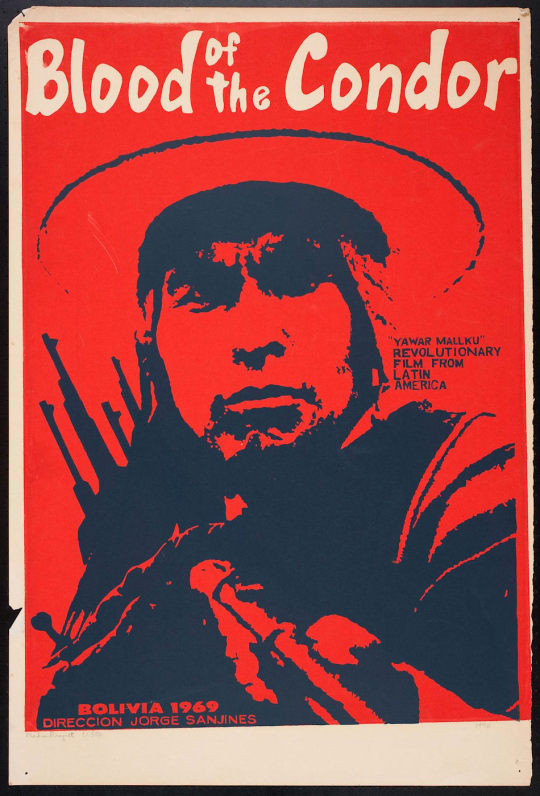
Blood of the Condor (Yawar Mallku), (1969), film poster. (director: Jorge Sanjinés)
"Ignacio (Marcelino Yanahuaya), the proud chief of a tribe of Quechua natives in remote Andean Bolivia, discovers that his wife cannot bear children. Like the other women of their village, she has been secretly sterilized against her will at an obstetric clinic operated by a purportedly beneficial aid group from the United States, with the covert help of the Bolivian government. Ignacio gathers the men of his tribe to exact revenge and bring justice to his people."
The story, which was based on accounts by indigenous people to Jorge Sanjines, provoked a public outcry which led to a government investigation about the Peace Corps' actions in Bolivia, ending in their expulsion from the country.
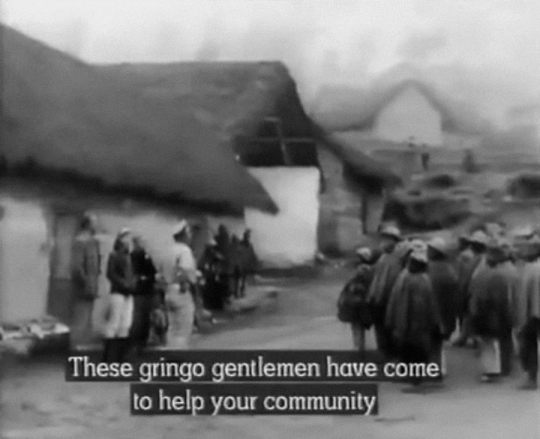

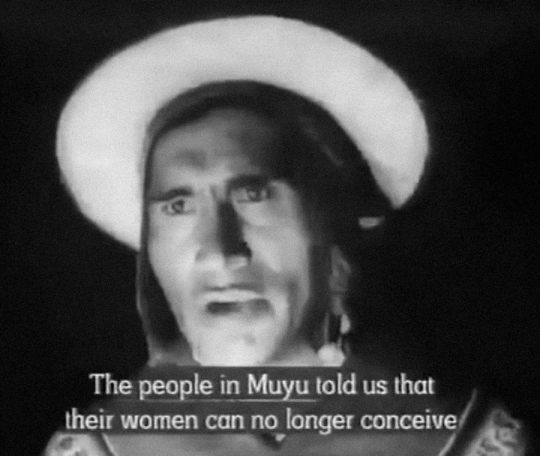
Part of an interesting albeit slightly flawed review on IMDB:
"... Molly Geidel, author of, "Peace Corps Fantasies: How Development Shaped the Global Sixties" found documents decades later clearly showing that the Bolivia Peace Corps director and volunteers with the agency, inserted IUDs in indigenous Aymara women at the time, despite not always having medical credentials and not being able to communicate well with the women.
So, it would seem that it wasn't the large-scale premeditated sterilization of a people that this film would have you believe (that is debatable), but none-the-less, an incredibly problematic policy practiced by the U.S. Peace Corps. It's not a long walk from nonconsensual contraception to accusations of population control. But the true story gets more complicated.
Long after this movie was released, a 2002 report by Peruvian Health Minister Fernando Carbone suggested that the president of neighboring Peru, all around asshole Alberto Fujimor, was involved in the forced sterilizations of up to 300,000 Quechua and Aymara women between 1996 and 2000 as part of a population control program called "Voluntary Surgical Contraception".
The United Nations and other international aid agencies supported this campaign, and yes, USAID provided funding and training for it. Whether these Western NGO's and Orgs were told that it was a voluntary family planning program (as the title suggested) or they knew it was a crime against humanity, I can't say.
The point is, the conspiracy theories this film uses to push its political agenda are based on either an eventual truth, or an ongoing truth that we simply don't have the full reportage of. So the movie's anger is prophetic or timely, but regardless, righteous."
Source:


59 notes
·
View notes
Text
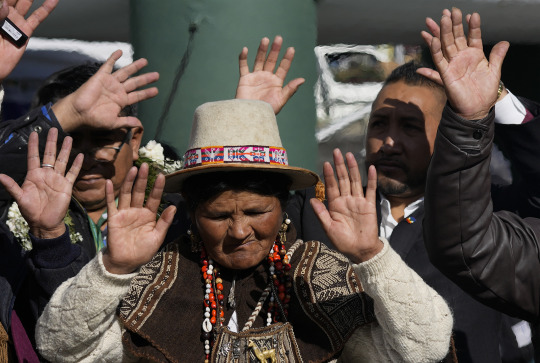
An Aymara Indigenous priest raises her hands as an offering burns for the "Pachamama," or Mother Earth, during a ceremony marking Earth Day in La Paz, Bolivia, Monday, April 22, 2024. (AP Photo/Juan Karita)
59 notes
·
View notes
Text
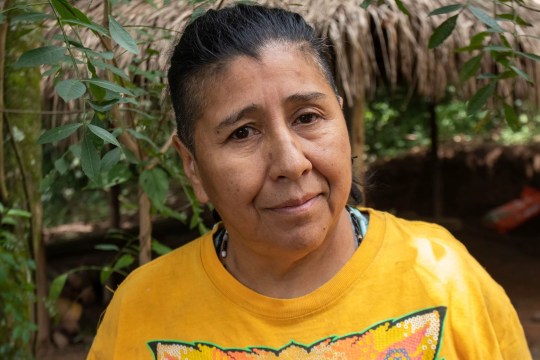
Julieta Paredes
Gender: Female
Sexuality: Lesbian
DOB: Born 1967
Ethnicity: Indigenous Bolivian (Aymara)
Occupation: Poet, singer, songwriter, activist, writer, artist
#Julieta Paredes#lesbianism#qwoc#lgbt#lgbtq#female#lesbian#1967#native#Indigenous#Bolivian#hispanic#poc#poet#singer#songwriter#activist#writer#artist
72 notes
·
View notes
Text
“In many cases, the histories and shared experiences of African and Native Americans are so intertwined, they are indivisible. At the same time, however, the shared history and the people that make up it’s chapters have become invisible.”
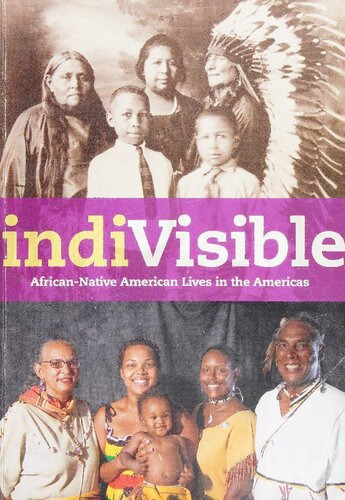
“Throughout American history, people of combined African and Native American descent have often struggled for acceptance, not only from dominant cultures but also from their own communities. In this collection of twenty-seven groundbreaking essays, authors from across the Americas explore the complex personal histories and contemporary lives of people wth a dual heritage that has rarely received attention as part of the multicultural landscape.
Illustrated with seventy-five paintings, photographs, and drawings, the book brings to light an epic but little-known part of American history that speaks to present-day struggles for racial identity and understanding.”
This book of essays, as compiled by Gabrielle Tayac, contains stories from all over the so-called “american” continents and explains the conjoined lives of black people, indigenous people, and the resulting black natives / afroindigenous peoples. I won’t spoil much of the book, because it’s a great read and you should read it cover to cover, but I can tell you it’s pretty diverse, and tells history from a black native decolonizing perspective, it even includes a short chapter about south american afroindigenous peoples, specifically afro-aymara from Bolivia, which was nice to see! I highly recommend it.
611 notes
·
View notes
Text

The Amaru or Katari (Aymara) a majestic twin headed serpent like creature depicted across Andean Civilizations, Originally said to have been capable of transcending spiritual and otherworldly boundaries for the world was Separated into the realm of the gods and birds, Hanan Pacha or the world above; the world where mankind resides the Kay Pacha or world of the present; and finally the underground realm of the dead or the Ukhu Pacha, the world below. where its said the Amaru would move the world by its shear size and force of will, creating many of the mountainous outcroppings seen in the region, or creating devastating earthquakes. This would gain the great beasts the ire of the of gods and leading to cataclysmic and deadly conflict's the great serpents deaths would create vast mountain ranges.
The revered creatures lore and depictions would be altered to suit changing society's and foreign colonial influence trying and suppress Indigenous beliefs and values, some Incan rulers even tried to harness this power by adopting name for themselves to try and cement their political gain . Eventually this lead to depictions that suited a more chimeric monstrous for, reflecting its old world counter parts, adopting traits from many other creature, to now be defeated by mere humans.
some cultures preserved and even re incorporated these new aspects with the old, creating hybrid depictions and gaining very broad symbolism such as the economy of water, and tending to the land, and even more cosmological aspects of space or wisdom, or simple fundamentals of the creativity of the peoples, sometimes these new Amaru could be seen clashing with each other. representing the more destructive side of nature, devastating the peoples and the lands, too only be stopped by the storms themselves or through the intervention of their old rivals, now taking a new cast of god's. once again through death creating the Mantaro valley returning to their earthly roots.

#amaru#dragon#serpent#creaturedesign#digital art#monster#inca empire#Andean civilization#mythology#south american#chimera#illustration
67 notes
·
View notes
Photo

On this day, 23 June 1751, Gregoria Apaza Nina, Indigenous Aymara rebel leader, was born in Bolivia. She led a major Indigenous revolt, along side her brother, Julián Apaza Nina (Túpac Katari), and sister-in-law, Bartolina Sisa, against Spanish colonial rule in the country. She and Bartolina took over the leadership of the rebels following the capture and death of Túpac Katari in November 1781. Learn more about Native American resistance in this book: https://shop.workingclasshistory.com/collections/books/products/500-years-of-indigenous-resistance-gord-hill https://www.facebook.com/photo.php?fbid=649457423894143&set=a.602588028581083&type=3
114 notes
·
View notes